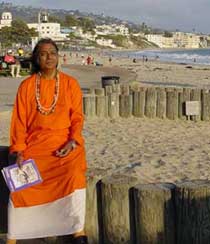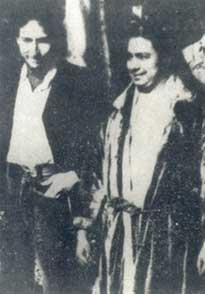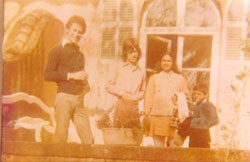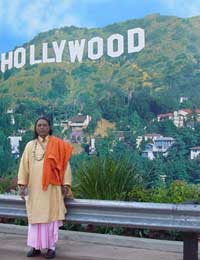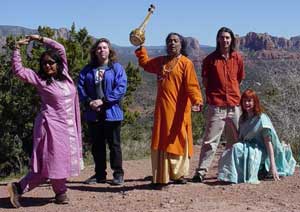Bouls of Bengal
A Unique Tribe of Wandering Minstrels
"I am He whom I love, and He whom I love is, I,
We are two spirits indwelling one body,
When thou seest me, thou seest Him,
And when thou seest Him, then thou doest see us both."
– Mansur Hallaj (The Great Sufi saint and martyr)
It is not unlikely that you, my esteemed reader of the instant article, will be travelling someday in a train on the relatively obscure Sahebgunj loop of Indian railways connecting Bihar through the districts of Burdwan and Birbhum of West Bengal. As is natural for your scholastic bend of mind and your never satiated urge for more knowledge, you are keen for a quick visit to Santiniketan, known world over as a place of learning with a marked difference, made famous by Gurudev Rabindranath, the first Nobel laureate of Asia and his illustrious father Rishi Debendranath Tagore. Also, with your never ceasing curiosity and leaning to always take a feel of the rhythm and pulse of life of the common people wherever you go, you have selectively boarded a local train which stops at every station in its own leisurely fashion and shows not much of any inclination to leave with haste. Or may be your are heading further west for a visual acquaintance with the famous Kali temple of Tarapith near Rampurhat, distinguished as one of the greatest shrines of this country by the holy memories, in the ancient time by Rishi Bashista and in the relatively recent time by the great mystic and worshipper of the tantric cult, Bamdev, more widely known as Sadhak Bamakhyapa. Or even may be on your journey for a still further west shrine at Nalhati, one of the 51 Satipiths lying scattered all over India and even beyond its present boundaries, for paying your homage to Mother Kali, the creator and destroyer of the universe. All these places alongside the Sahabgunj loopline of the Indian railways are located within the district of Birbhum, about 200 Km west of Calcutta (Kolkata).
The train has stopped at a small station, say Bataspur, Sainthia or Swadhinpur and suddenly overlapping the clamors of your never silent co-passengers or the cacophony let loose by the never subdued hawking vendors, a lone but distinct voice of a singer, rustic in flavor but singularly sweet and melodious in character, becomes audible to you as a pleasant surprise. The physical features of your entertainer are yet to be unveiled for you as he is still struggling his way forward through the crowd of the travelers in your compartment. You can't surely take him amiss for a common beggar as, with your discerning ears for talent, you have already awarded multiple credit points to him, acknowledging his proficiency as a vocalist and a musician.
The sweet melody of his voice catering a devotional type or a folk based song, mostly pensive in mood or though seemingly joyful in its outer fabric, actually sad in its inner ambience, is made sweeter and more melodious by the occasional sounds from a stringed instrument. You are listening with rapt attention and craning your eyes above the wall of the crowding passengers in a bid of impatient waiting, to have a look at your itinerant vocalist who has assured you already of a class of his own.
Yes, here he is now at last! Like the uniqueness of the quality and character of his song, he is also an object of distinction in his appearance, to be treasured up in your mind in the years to come or to be photographed carefully from different angles. You are more lucky if you are travelling with a handheld movie camera or a latest digital type for, like his pleasant song he is decidedly pleasing also to look at, dancing in a suave, gentle gesture to the rhythms of his own song, at times swirling in a complete circular motion on the spot where he has now reached, on one foot, the small metal bells (ghungur or ghunroo as they call in the local language) tied around the ankles of his feet emitting a supportive sound. This is surely not all. Look he has in his right hand a one-stringed improvised instrument which they call 'EKTARA' literally meaning an instrument having only one string. He has also another one-stringed instrument in his left hand known as 'Gupijantra' which, when played with the help of a polished piece of coconut shell, scoops up an uncommon, never heard before sound, peculiar to hear isolated but suitable when played as an accompaniment, mainly a filler or interlude music for his song. No, he can not play the 'Ektara' and his 'Gupijantra' simultaneously as the later instrument demands employment of his both hands when played. But wonder of wonders! Look! Like a one-man orchestra, he is taking access to yet another instrument when he is not using his 'Gupijantra'. This is a small sized drum type instrument, an indigenous version of a locally made percussion, the size of your palm, held in his left hand and slung with a string from his shoulder. Surely, he is playing this together with his 'Ektara' simultaneously, to provide occasional beats to one of his fast paced songs.
May be you are keen to collect one or all of these accompanying instruments, the 'Ektara', the 'Gupijantra' and the miniature drum to keep them as your memento or even with a distant ambition to learn and sing like him in one of the coming days. Be advised and become wise to spare yourself of the trouble of a fruitless hunting. You can not purchase any of these in any musical shop of the world. Most probably, the instruments are self-made or made at the exclusive guidance of the singer himself, by a village artisan living next door, meant for the exclusive use of his brother musician and gifted to him as a gesture of love and appreciation. He is not a professional and most probably he will decline to make another set for you even if all the money you have is proposed to change hands.
But lose not your heart as there is still a chance for success and not a very difficult one. Go and befriend the singer in a bid of genuine affection and he will be a lifetime friend of yours as he has a heart made of pure gold flowing with the milk of love and compassion for mankind walking the face of the entire earth which is the real inspiration of his angelic song. The instruments being now used by him will be all yours after the song is over.
This way you will find yourself placed beside your all time favorite, the great Bob Dylan, who has become an ardent admirer and life long friend of Purnadas Baul of Golemale, Golemale Pirit Korona or Amar Jemon Beni fame. If your present singer is now singing one of these songs, do you feel drawn to lend an extra ear to be not very remotely conscious of an affinity of the mood and mode singing of his song with that of Dylan's famous number Slow Train Coming or How Many Roads Man Must Walk Down? Don't blame yourself as being over fanciful. There is substance in your fancy as the both sets of songs, being ethnic in character, belong to the same category of folk/country type songs having common roots, as the musicologists and researchers in primitive arts and culture have now almost unanimously opined. They are distant members of the same brethren.
Ask your singer his name and he will introduce himself as, may be, Sudhir Das Baul, a no less talented singer of Boul songs. If you are more inquisitive and insistent, ask him and be informed that he is presently on his journey back from Kolkata where he had been to record songs at Kolkata Television Center or the All India Radio, Kolkata and the songs are being broadcast or aired right at present and he is not at all bothered to hear himself singing. Give him a few coins and he will accept them with salutation in a humble but dignified gesture. No, he is not a beggar in the traditional sense but an adherent of a fast decaying religion which has mandated him to earn his living only this way, as the orthodox Vaishnavites do, following dictates of Madhukari which means sanction for begging strictly as little as necessary for a day's living only. Yes, Boul, in the true sense of the term, is not a class of singers or a class of songs as is commonly confused, but a non-Vedic religion dating back to not less than eight hundred years which has assimilated in itself ideas and beliefs from Buddhism and more particularly the Vaishnab and Sufi cults of Hinduism and Islam in equal prevalence.
The term 'Boul' appears to have taken its origin from the Sanskrit word 'Byakul' meaning 'restive with emotion', 'forgetful of his material surroundings', 'disarrayed in dress, habits and behavior' etc. A synonym of this word is 'Aul' which has the same meaning as 'Boul', but seems to have originated from the word 'Akul' or may have taken its root from the Arabic word 'Wali' which in Sufi literature is applied for a man who has attained superior consciousness having known the Almighty. The Muslim Bouls who underwent marked and decided influence of Sufism, are called 'Aulias' to distinguish them from the 'Bouls' of the other class, the adherents of their ancestral Hindu religion by practice but essentially believers in the same faith. In West Bengal and also in the erstwhile East Bengal, now Bangladesh, they (the Muslim Bouls) are also known as Nerar Fakir, Besra Fakir or Marfati Fakir and Bedati Fakirs. 'Nera' means a 'shaven headed person'. Among the Buddhist monks, it was their practice as part of their religion to shave off their heads as a symbol of relinquishment of all fascinations for worldly attractions and stringency of living as well.
In the middle of the 8th century A.D, the first Gopaldev by a republican choice was elected to the throne of Bengal and he founded the Pal dynasty. At that time Tantric Buddhism was at its peak of influence in Bengal, having two opposing doctrines of preaching, viz., Bajrajan and Sahajjan. A large class of poor and underprivileged people at that time first adopted Sahajia Buddhism and subsequently got converted to Islam. Though Muslim by their religion they continued to carry some of their old religious practices and ideas. They would shave off their heads as in their past and kept on practicing and believing in many of the basic creeds of Sahajia Buddhism. They came to be known as 'Fakirs' or 'Nerar Fakirs'. They were also strongly influenced by Sufism and simultaneously, to some extent of the Vaishnavism of Goud, propounded by Sri Chaitanyadev.
Another down-trodden, poor class people which did not convert to Islam despite neglect and oppression meted out to them by the upper strata members of the contemporary society and had to stay aloof as outcastes, chose to espouse the new ideas of Vaishnavism but kept on adhering to some of the essential practices of the tantric Buddhism. To indicate their converted status from Buddhism to Vaishnavism, they would be known as 'Nera-Neri'. It is said that Biravadra, the son of Sri Nityananda, brought them under the fold of Vishnavism. The Bouls believe that Sri Chaitanya, the great proponent and preacher of the Vaishnav cult of Goud, was the father of their religion and the book named 'Chaitanyacharitamrita' by Sri Krishnadas Kaviraj is believed by them to contain hidden references of the basic concept of their religion. The communion of the eternal Masculine and the eternal Feminine, symbolized through the love and union of Radha and Krishna known to them as the Radha-Krishna creed is also synonymous to them as Sri Chaitanya creed.
The Bouls believe that Sri Chaitanya was the symbol of the ultimate union of the eternal Masculine and the eternal Feminine, viz., Radha and Krishna. This concept of the Radha-Krishna creed or the Sri Chaitanya creed also exerted strong influence upon the Muslim Bouls. They accepted Sri Chaitanya as a great prophet and since many of the ideas of Vaishnavism of Goud preached by him echo the same beliefs and religious emotions nurtured by them, many of their songs are found to have been composed on these ideas.
The Muslim Bouls were also greatly influenced by Sufism which believes that 'Noor' or the sublime glory of the Almighty Allah gets reflected in the 'Nabi' as the symbol of His all embracing love for the mankind and he exists in all men of the universe which He created. 'Nabi' according to their belief is the fullest manifestation of the power and glory of the Almighty. He is 'Insan-ul- Kamil', the complete Man." The expression Al Insan-ul-Kamil, literally meaning "The Perfect Man occurs for the first time in the writings of Ibn'ul'Arabi (Fasus-ul-Hikam) and it denotes the highest type of humanity. In other words it represents a Sufi who has realized his essential oneness with God. Ibn'ul 'Arabi bases his theory of the 'Perfect Man' on a pantheistic monism which regards: "the Haqq" or the Creator and the Khalq or the Creatures as complementary aspects of the Absolute Being".
The 'Nabi', being the Insan-ul-Kamil, is the symbol of great spiritual inspiration for these Sufi Bouls like Sri Chaitanya who also exerted unmistakable influence on them, being a votary of the religion of man, the doctrine of realization of God through love and submission. The idea of spiritual egotism and oneness with God preached by the Sufi mystics find resonance in the Hindu concept of Atman:
"The spirit within me is smaller than a mustard seed,
The spirit within me is greater than this earth
And the sky and the heaven and all these are united.
It is Brahman."
So in the songs of these Muslim Bouls one discovers a unique secular approach in defining the mystery of the Creation, the bondage of divine love between Man and the Almighty, a generous acceptance of the both faiths of Vaisavism of the Hindus and Sufism of the Muslims.
The Bouls of the Hindu class usually dress like the Vaishnabs wearing a string of beads around their necks and adorning their foreheads with tilaks. They wear on their persons a loosely fitted overall like clothing either yellow or red. Many of them keep long hairs arranged as a topknot known as dhammil in their community but not all of them keep their hair in the same style. At the time of going on rounds for collecting their alms they take along a walking stick, a coconut shell cut in halves and a makeshift bag shaped out of a single piece of cloth called by them as 'Jhola' or 'Jhuli'. They keep long beards and moustaches. But some even take regular shaves. The Muslim Bouls, however, wear white overalls or a two piece dress, a white lungi and a white vest on the upper portion of the body.
Though some of the Bouls may have continued to remain a begging class, most of the others either cultivate or indulge in carpentry or livestock breeding for living. Some even have started business or have taken up job and they have completely relinquished the practice of begging which was once a part of their rituals and worshipping.
From towards the end of the 19th century the proper nuances of the term 'Boul' started getting diluted. The 'Bouls' began symbolizing a particular class of folk type songs sung by a particular class of itinerant singers, either for a living or for an identity as entertainers of a distinct and different category. This is decidedly a departure from the true understanding of the word 'Bouls' and a misconceived approach to looking upon a unique class of adherents of a distinct religious faith having their own socio-religious customs and quest for the ultimate truth, i.e., realization of the Divine and the supreme manifestation of the powers and spirit of the Almighty reflected through the soul of all men on earth.
'Bouls' are, truly speaking, a religious sect and not a mere community of wandering minstrels like the French troubadours who roamed about in different parts of France and Italy in the 11th- 13th century singing love songs and heroic deeds of the knights. The 'Bouls', though now a decadent and a fast reducing community, have their own faith and philosophy, rituals of living and worship, vast experiences of religious journeys gained and transmitted down by the highest attainers of their faith and above all a definite attitude to life and the universe.
As the 'Bouls' in the past were strongly influenced by the ways of the Buddhist Sahajiya class of worshippers, the word 'Sahaj', meaning in literal sense, the simple, finds repeated mentions and reference in the songs and customs of the 'Bouls'. The mention of the word is found to first occur in the Buddhist Sahajia texts. Then in the middle age we see use of the term in the compositions of the adherents and believers of the Bhakti as well as the yogic cults in the North-Western part of India like Saint Kabir and the Vaishnab sahajia worshippers.
The 'Bouls' strive for attaining the ultimate realization or the Nirvana, the highest form enlightenment, by reaching the 'Sahaj' state of mind like the Buddhist sahajias. This state of mind according to them is the ultimate goal of their worship, synonymous with 'Nirvana', 'Mahasukh(meaning the purest form of joy)', 'Sukhraj(meaning the princely state of pleasure)' etc. When this state of joy is attained by the worshipper, he loses all consciousness or sensitivity about the teller and the told, the learner and the learned, the consumer and the consumable.
This state denotes the existence of the barrier of Vikalpajal meaning veil of Maya as opposed to nirvikalpa state of mind. By piercing through this Vikalpajal one attains the Nirvikalpa, the most sublime form of joy which is not dissolution of the ultimate but attainment of enlightenment in its purest and the final form through sahajia path of worship and meditation. In this state one crosses past in his quest all menace of doom and degeneration. 'Jahi Mon Pavan Na Sanchrai,/ Ravi, Sasi Nahe Pabesh (Where the mind and all manifestations of material living become stilled and where or in which stage even the Sun or the Moon is refused admission).
After the advent of Sri Chaitanya a strong musical environment in Bengal established itself as a way of worshipping in the form of nam sankrittan (chanting of the names Hari & Krishna), Viashnab padavali krittan ( a semi or near classical form of Indian music sung by expert singers setting music to selected parts of Vaishnab Padabalis composed by famous composer like Chandidas, Gyandas, Govindadas, Joydev etc. The talas, meaning the beats applied, often tend to be of very difficult matrixes. These are extremely lyrical in character and mostly composed on the theme of love and separation between Sri Radha and Sri Krishna). For this reason, it got almost spontaneously and unanimously acknowledged that if any idea or emotion relating to God and Religion had to be expressed, it ought to be through song and music. Since the Bouls derived inspiration substantially from Vaishnabism, they also chose, in a way of natural selection, their songs to be the medium of expression for their faith and ideas.
The Fakirs of Sufi faith also used to assemble in solitude to exchange and express their religious ideas and experiences through songs and dances known as 'Sama'. The Bouls of the Hindu community and the Muslim Fakirs of Sufi faith met together separately in their respective joints (akhras or asthanas) away from the locality and would discuss details of their mystic faith and realizations, through songs. Songs were their mode of self expression and an inseparable part of their existence.
It was around 1650 A.D which we may call the time of first evolution of Boul songs which flourished through the 18th century unto the end of the 19th century. Understanding the metaphysical through the physical or searching for the Reality behind the Appearance, constitutes the basic concept of the religious quest of the Bouls. This they call as the 'Rup-Swarup Tatta'. The mystic journey of the soul centering round the physical body for liberation from the bondage of physical and worldly attractions leading to the realization of the ultimate truth and joy of the highest kind, is the root of the essential spirituality of the Bouls. Holistically and simplistically speaking, this is the essential idea of the Tantric mode of worshiping developed in India in the long past and subsequently passed on to the Buddhists, both of the Bajrajan and the Sahajjan sect, the Vaishnab Sahajias and the Bouls of the later time.
The Bouls believe that the entire truth for the seeker of the ultimate realization can be traced in the body itself and not beyond. This exists in the form of a divine pleasure born out of the communion of the eternal Masculine and the eternal Feminine, Shiva and Shakti or in the other words, Pursha and the Prakriti. Union in love of the Pursha and Prakriti and pure joy created out of that is what the Bouls call the 'Sahaja' state of Nature and all existence. By rigorous and successful yogic practices under the expert guidance of a Guru (Preceptor, the religious guide) one can reach this stage. So the physical body is of the utmost importance for the quest of truth for the Bouls. It is the 'Bhanda (the receptacle) containing all and everything of the 'Brahmanda (the Universe)' in the miniscule form. This body centric approach of worshipping has been echoed time and again in the Boul, Murshidi, Marfati songs down the ages and can be traced back to the 800-1200 AD in the compositions known as 'Charyapad' which reflects the essential philosophy of Buddhism. In the following composition of Siddhacharya Lui Pa of that time this idea has been emphasized very briefly but very prominently:
" Ka A Tarubara Panchabi Dala,
Chanchal Chitta Paitha Kala,
Dirh Kariya Mahasukha Pariman,
Lui Bhanai Guru Puchhiya Jana"
Here the body has been imagined as a tree of which the branches have been equated with the six senses of the body. For the veil of Maya and absence of the true knowledge the fragile mind becomes restless and attracts as consequence several sufferings for the soul and the body. So one has to control the allurements of the material pleasures which, when achieved under the able guidance of the Guru, can bring joy of the highest kind.
Long before the Muslims came to India, anarchism, licentious leanings and practices in religion, oppression for the poor and the common mass of people were let loose by Brahmanic Hinduism (Brahmanyabad) in the contemporary Bengal. The oppressed class reached the peak of their tolerance and their frustration. Consequentially, against this backdrop and as a weapon of protest, the religion of Lord Buddha laid its base and flourished in this part of the country exerting decided influence on the masses for quite sometime. Later in the 13th Century, invaders from Turkey took political control of the of the land and many devotees of the Sufi cult, Pirs and Darbeshes came in their trail and they, mainly the Sufis, preached as the basic doctrines of their faith declaring the soul of man to be the source of all powers. They assured all seekers, without discrimination, attainability of the joy of unification with the soul of the Creator through prayers and refinement. What they preached had affinity in its essence what the worshippers of the Buddhist Sahajia faith had said. The stock of the common people which descended from the Buddhist Sahajia clan but did not return to the Hindu fold by adopting as their faith , the Vaishnabism of Goud which was also conceived and propounded by Sri Chaitanya as a protest and religious option against the oppressive Brahmanism at the time, got converted into Sufism of Islam. Thus the community which had once established its own identity as adherents of a new and different kind of religious faith subsequently got divided into two separate branches of the same brethren. The Hindu followers became known as 'Bouls' and the Muslims as 'Ayuls', Marfati Bouls, Murshidi Fakirs, Bedati Fakirs etc. This is how their faith deviated from the preaching of Vedic Hinduism which puts emphasis upon ceremonies and rituals and worship of multiple godheads. Contrarily, the religion of the Bouls is man-centric and truly secular in belief and approach, imagining Man to be the ultimate reality as part of the supreme Creator, above all barriers of caste, creed and inhibitions.
The laterite zone of the western part of the erstwhile undivided Bengal in the districts of Birbhum, Bankura, Burdwan is known as the home of some famous Bouls like Padmalochan, Jadubindu and in the recent time, Nabanidas Boul, the illustrated father of Purnadas Boul of global fame. Panja Shah of the middle Bengal is a famous Sufi Boul of all times who in his early youth kept close company with the Vaishnabs and his compositions echo positive influence of their cult. But Lalan Shah or Lalan Fakir is universally acknowledged as the most famous among the Bouls of the both categories of all times. He is accepted as a 'Siddha Purush (meaning one who has attained enlightenment of the highest order). He had substantial knowledge of the Vaishnabite faith and religion and simultaneously of Sufi cult and literature. His compositions still very popular among the singers and listeners and widely sung in the entire region of the present West Bengal and the erstwhile East Bengal, now Bangladesh, have greatly enriched the folk literature and the domain of poetry of the entire Bengal in both the spheres. He himself was and still remains a living example of unification of two faiths, Islam and Hinduism, a unique personification of equal love and respect for two apparently opposing religious concepts.
The life story of Lalan Fakir has always remained an interesting saga of fate and sudden turn of events any mortal may fall prey to. It has been a chosen, all time favorite subject for play, movie, novel and Jatras (rural form of drama acted on a open air stage with spectators sitting on all three sides keeping only one side closed for entry and exit of the actors) over the ages and popular T.V serials in the present.
Lalan was born, the story goes, in an orthodox Hindu family. When he was still young, he went out to visit some far off places of religious interest with some of his friends and associates from his village. They had completed their pilgrimage and were on their way back. Lalan, when still to cover some more miles from home, contracted small pox, then an almost incurable lethal disease. Lalan went into unconsciousness under severe spell of the malady and his fellow pilgrims taking Lalan to be dead, left him on the way, outside a village. An elderly kindhearted, childless woman belonging to the Muslim community found him in that condition when she was approaching a nearby canal to fetch water. Lalan, though almost dead by now, had not really died which the lady could have felt by her experience and motherly affection. One pirbaba (an enlightened hermit of Sufi faith) living in the village and believed by the villagers including the woman who was an ardent follower of the god-man, to have supramental powers brought Lalan to senses and ultimately cured him at the request of the woman. Since the woman and the villagers could not be sure of the religious identity of Lalan who had absolutely forgotten his past, though now completely recovered, was adopted as son by the childless woman and was initiated into Islam by the Pirbaba. Long after, when Lalan had by then acquired sound knowledge of Islam and particularly of the mystic faith of Sufism under the tutelage of the Pirbaba and had got back his memory of the past, he went back to his original village where his parents and wife lived. Under wrong information conveyed to them by Lalan's fellow pilgrims of the past, his kindred had by now taken him to be dead and had performed his last rites. Lalan's parents refused to accept him back into their family fearing social boycott and his wife also declined to accompany him and live with him in his new found home. Lalan got back to his surrogate mother who was almost dead now with grief, missing his godsend child, was only overjoyed, hardly believing her luck for the second time. Lalan continued to live in the village and the prodigious possibilities lying latent in him as a poet and a religious visionary flourished into a full blown genius in time under love, affection and guidance of his parents and his Guru. For the rest of his life he kept alive in his heart his love for the religion he had acquired by birth which he successfully combined with his respect for the religion he adopted later. Thus he became a staunch believer and exponent of a new, secular faith that yearns to reach for the love of the Almighty by loving all men on earth irrespective of their caste, creed, race and religion. This magnanimity of his faith and understanding has been very aptly reflected in the following lines of his song, perhaps the most well known and the most popular among his compositions:
Sab Loke Koy Lalan Ki Jaat E Sansare
( All are anxious to know what religion of the world
Lalan actually belongs to)
Lalan Bole Jaater Ki Rup Dekhlam Na Ei Najore
( Lalan submits his ignorance and says,
" I have failed to visualize how one's religion looks like")
Jagat Jure Jaater Katha, Galpo Kore Jatha Tatha
(They, from all corners of the globe,
Keep on talking about religion
And indulge in idle chatting on the subject)
Jawa Kimba Asar Belai Jaater Chinha Roy Kare?
(But, who bears any mark of religion
When he is born or sets out for his last journey?)
My dear reader you have by now almost reached your destination and have known a bit about the descent, culture and religion of your new-found friend. He is also set to leave and you might be keen to know about and acquaint yourself with many more of his class. You are welcome and if you can make it next time, please note down in your travel book names of at least two places, viz., Kenduli on Ajoy river in Birbhum itself which is famous and known as the birth place of Kavi Joydev of Geet Govindam fame. An open air, nightlong Boul Mela ( a fair where many Bouls meet and dance) every year is organized here where many Bouls of the Hindu and Muslim community meet together on the last day of the winter month of Poush of the Bengali calendar, to sing in honor of poet Joydev, known to be a great devotee of Lord Krishna. Another famous spot and a place of annual assembly of Bouls of another sect known as 'Kartabhajas' is Ghoshpara near the modern sub-divisional town of Kalyani in the Nadia district, located about 60 KM north of Kolkata. Here also many Bouls meet every year on occasion of a fair known as Sati Mar Mela (the fair in honor of Sati Ma). Sati Ma is worshipped by the members of the Kartabhaja community, a sect of the Bouls of Vaishnavite faith as a god-woman and the founder lady of their order. A nightlong fair is organized by them each year on the previous night of Holi (Doljatra) before the temple of Sati Ma, like the one in Kendubilwa (Kenduli), when many devotees of various faiths besides the members of the Kartabhaja community assemble and pay homage to her. The Kartabhajas (literally meaning worshippers of the Head of the Community or Sect) have an interesting story of their origin, evolution and faith. But please don't tempt me to go in for that this time. Viswa Bharati also organizes a Boul Mela at Santiniketan each year as poet Rabindranath was an admirer of Boul songs and the philosophy and ideas underlying their traditional compositions are essentially in agreement with the spirit and ideals of Brahma Samaj which he belonged to and of which his father was a great proponent.
Dear reader, let me finish with a word of caution about the traditionality and the recent trend in Boul songs as very understandably you may be interested to collect some of them now as an admirer, for your listening in solitude when you go back to your place and also may be inclined to collect some as memento for your like minded friends back home who have not been fortunate like you to be personally present in the land of the Bouls. Yes, Boul songs are available on cassettes, CDs and gramophone records. But most of them are from the amateur or professional modern composers and barring only a few, they are not traditional Boul songs from the old and enlightened Bouls who had vision and true inspiration, having progressed and reached milestones in their religious quest for the love of God. This trend for amateurish composition of Boul songs outside the true Boul community started towards the end of the 19th century at the hands of Sri Harinath Majumder who composed in the pseudonym of Kangal Harinath or Kangal Fikirchand and Sri Golok Chandra Bandyopadhyay who wrote using the nickname Deen Baul. These amateurs belonging to other vocations and never initiated as Bouls in the true sense added a new dimension to the stock of traditional Boul songs writing profusely on a variety of subjects, social, political, revolutionary ideals of the patriots towards the end of the British rule in India etc. Unlike them, the traditional Bouls restricted their compositions on the extremely limited themes of the philosophy of their religion, mystic journey of the soul imagining the physical body as the total embodiment of all mysteries of existence, the rigorous practices and preparations under the able guidance of the Guru for realization of the final truth and the like themes only. The modern Boul songs try to replicate the mystic trend in expression used by the traditional Bouls known as Sandhya Bhasa ( a double meaning language having an idea deep inside, resembling the appearance of a twilight, with its mixture of light and shade creating a sort of illusion. Sandhya means twilight and Bhasa means language). But what is there to do? Under the impact of rapid industrialization and other socio-economic factors the Boul community is on their path to fast extinction. The modern Bouls have kept alive atleast some semblance of a rich heritage and we may have no objection to the compositions of the amateur composers. Afterall, Gurudev Rabindranath also loved to imagine himself to be a Boul and composed quite a few songs in typical Boul fashion as in the following lines:
"Amar Praner Manush Ache Prane
(He who is my soul-mate lives in my soul itself)
Tai Heri Taye Sakal Khane
(Thus I see him everywhere)
Achhe Se Nayan Taraye, Alok Dharaye
(He exists within my eyes, he exists in the stream of light)
Tai Na Haraye
( So he is never lost)
Ogo Tai Heri Taye Jethaye Sethaye Takai Ami Jedik Pane
(So he is visible for me here there and at all places wherever I cast my eyes)












